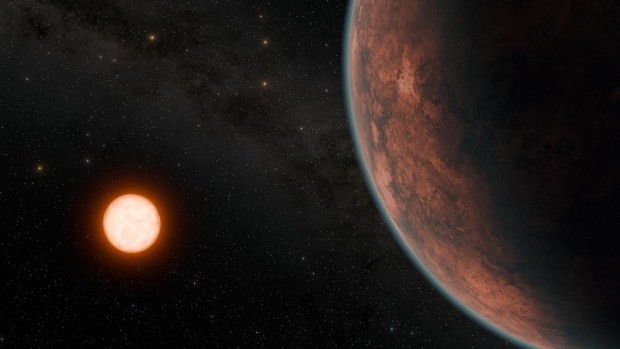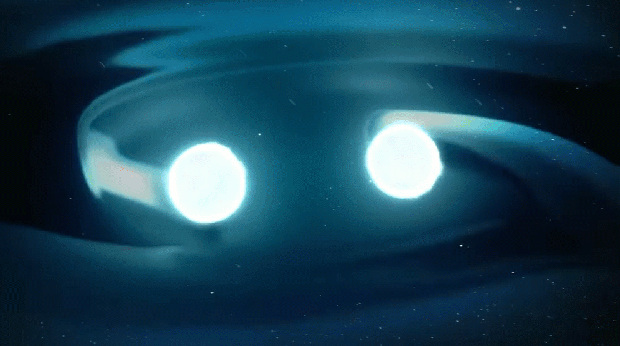Gliese 12 b could be the nearest temperate world like our own located to date — but don’t book your travel tickets quite yet.

An artistic conception of Gliese 12 b, which orbits a cool, red dwarf star 40 light-years away, from Earth. Credit: NASA/JPL-Caltech/R. Hurt (Caltech-IPAC).
Astronomers are constantly adding to the ever-expanding catalog of more than 5,000 confirmed exoplanets. But Gliese 12 b, located 40 light-years away in the constellation Pisces, could be the most sensational find to date. Its discovery is outlined in a paper published today in Monthly Notices of the Royal Astronomical Society.
The planet, which is a bit smaller than Earth and similar in size to Venus, has an estimated surface temperature of 107 degrees Fahrenheit (42 degrees Celsius). That’s admittedly warmer than Earth’s mean temperature of 59 F (15 C), but cooler than many other observed exoplanets. And that temperature means it could, conceivably, have liquid water trickling over its surface.
However, while exciting, the discovery of such a potentially habitable world comes with a caveat: Gliese 12 b may not have an atmosphere. While it could very well have an Earth-like atmosphere, it could also have one more like that of Venus — a planet certainly not known for its habitability — or may have no atmosphere at all. Or perhaps it could even have an atmosphere unlike one we have ever seen before.
“Gliese 12 b represents one of the best targets to study whether Earth-size planets orbiting cool stars can retain their atmospheres, a crucial step to advance our understanding of habitability on planets across our galaxy,” said Shishir Dholakia, a doctoral student at the Centre for Astrophysics at the University of Southern Queensland in Australia, in a press release. Dholakia co-led the research team that made the discovery alongside Larissa Palethorpe, a doctoral student at the University of Edinburgh and University College London.
The value of a stable star

A crucial factor when it comes to retaining an atmosphere is the level of activity on a planet’s host star. Red dwarf stars — like Gliese 12, which the newly discovered planet orbits — tend to be magnetically active, and so they routinely produce powerful X-ray flares. However Gliese 12 does not exhibit this behavior. This, the researchers say, increases the likelihood of any atmosphere the planet might have remaining intact.
Early in its lifetime, our Sun was also more active. “It is thought that Earth’s and Venus’s first atmospheres were stripped away and then replenished by volcanic outgassing and bombardments from residual material in the solar system,” Palethorpe noted.
Today, “the Earth is habitable, but Venus is not … Because Gliese 12 b is between Earth and Venus in temperature, its atmosphere could teach us a lot about the habitability pathways planets take as they develop,” she said.
A landmark observation
The discovery of Gliese 12 b was made using observations from NASA’s Transiting Exoplanet Survey Satellite (TESS), which, to date, has found more than 440 confirmed exoplanets.
Gliese 12 b is a part of a small but incredibly significant group of temperate, Earth-sized exoplanets that are near enough for detailed atmospheric studies. Thus, it offers a valuable opportunity to understand the diversity of planetary atmospheres as well as the factors that contribute to habitability.
“Much of the scientific value of this planet is to understand what kind of atmosphere it could have,” Dholakia added. “Since Gliese 12 b gets in between the amount of light as Earth and Venus get from the Sun, it will be valuable for bridging the gap between these two planets in our solar system.”
Gliese 12 b could, ultimately, help researchers better recognize exoplanets that have similar conditions to our own, and also raises hopes that other cool stars in the Milky Way — where around 70 percent of stars are red dwarfs — may be orbited by temperate planets with the potential for life.
Even if it is determined that Gliese 12 b is not conducive to Earth-like life, further study of the planet could still enhance our understanding of how a planet’s internal structure is influenced by its star’s composition and the environment the world forms in.



